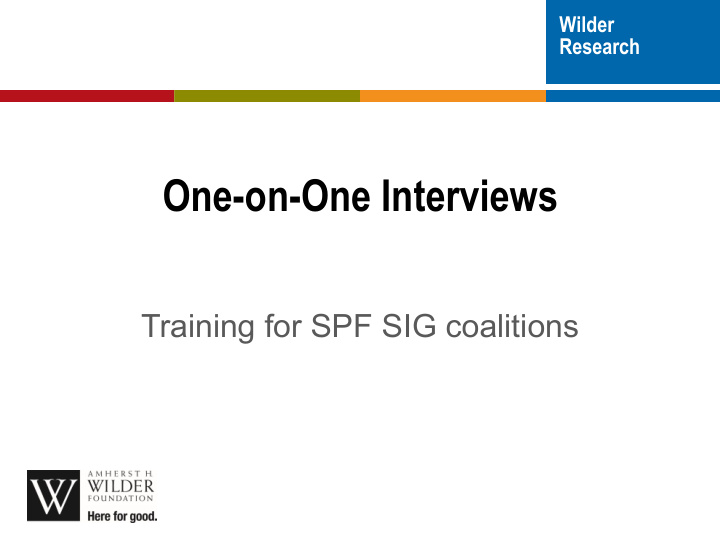



Wilder Research One-on-One Interviews Training for SPF SIG coalitions
Goals for today After today, you will understand… – The purpose of the One-on-Ones – The One-on-One process – The tools – The ways to protect the privacy of community members
Main purposes of SPF SIG One-on-one Interviews 1. Gather information about community readiness and prevention infrastructure. 2. Build relationships with and recognition of the coalition among a broad group of community members. 3. Shape buy-in for future community readiness assessment efforts. 4. Develop the coalition’s capacity in conducting research interviews.
Detailed process for coalition members Share Conduct Carry out Synthesize information practice assigned own with interviews interviews interviews coalition To complete this process, you will use: Protocols One-on-One Interview Guide Synthesis Form
Practice interviews Before you schedule your actual interviews, you will have three opportunities to practice: – As a group during this training – Individually on your own – Individually with Wilder Research
Using the One-on-One Interview Guide
Before you begin Schedule approximately one hour Identify a convenient, neutral location Fill out introductory information up-front Review the tool and background information to: – Understand the purpose of the interview – Feel comfortable asking the questions – Feel at ease answering questions about the interview
During the interview – Set the tone Make sure the participant understands why you are talking to him/her Maintain a positive attitude Focus on the participants’ thoughts and experiences rather than your own Stay unbiased; do not express your opinions or reactions Keep the interview professional, not personal
During the interview – Keep on track Read questions exactly as written – Do not skip a question because you think it was answered earlier Help participants if they have trouble answering – Reread question and give them a minute – Okay to say “don’t know” Balance detail and overload – Give participant time to voice their opinion – “Nudge” participant when necessary
During the interview - Helpful nudges If the participant is… Focused on another topic or question: – “We’ll get to that in just a minute, but first could you tell me a bit more about…[RESTATE QUESTION]” Rambling or wordy: – “Thanks for your thoughtful input! Now, let’s move on to some other questions…” Not answering or understanding the question: – “What I am really asking about is…[RESTATE QUESTION]”
During the interview - Probing A probe is used to encourage the interviewee without influencing his/her responses. Probe for clarity and completeness: – Better understand what the participant is saying – Collect complete information – Make a participant feel comfortable and supported Never use “leading” probes
At the end of the interview Respect the amount of time you promised – Stop when you said you would stop – Give them the option of completing the interview Complete “housekeeping” tasks – Confirm their contact information on the cover sheet – Provide them any contextual information (if needed) Thank them Reflect on the interview
Using the Synthesis Form
Synthesizing information Complete one form for each sector and each sub-community, as relevant Think about ALL interviews completed Count multiple choice answers Identify patterns (see next slide) Provide reflections
Identifying patterns Common themes Differing themes Thoughts or opinions that Two or more different multiple people shared or thoughts and opinions that a couple of people about the same topic or shared repeatedly related to a common theme, strongly supported on both sides, and/or significantly different
Submitting your forms At least 3 weeks before the discussion meeting submit to Wilder: – One copy of each completed Synthesis Form – One copy of each One-on-One Interview Guide Bring one copy of the Synthesis Form to the discussion meeting
Reporting the results Think about ALL interviews completed Prioritize the findings Protect privacy – Separate individual information from responses – Limit talk about individual responses – Be respectful of diverse perspectives Develop action steps Plan follow-up discussions
Questions?
Now we are going to read through the One-on-One Interview Guide
Recommend
More recommend